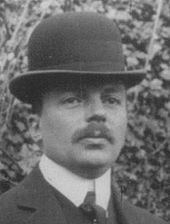Name Ernst Haiger | Died 1952 | |
 | ||
Ernst Haiger (10 June 1874 – 15 March 1952) was a German architect.
Contents
Life and career
Haiger was born in Mülheim an der Ruhr. He studied at the Technical University in Munich, under professors Josef Bühlmann, August Thiersch and Friedrich von Thiersch. The latter was his most important teacher who also promoted him. In his younger years, Haiger was already a successful architect. Still a student, he entered a draft for the Leipzig Battle of Nations Monument which successfully reached the competition's short list. His drafts for villas and interior room decoration were displayed at the Munich Glass Palace Exhibition in 1898 and attracted a lot of attention. He had designed them with Henry Helbig, with whom he shared a studio, working together until about 1903. As from 1905 he worked for the Munich Vereinigte Werkstätten für Kunst im Handwerk (United Workshops for Arts in Handcrafts). In 1920 the reorganisation of this society was given into his hands, along with Rudolf Alexander Schröder and Paul Ludwig Troost. In 1917 the Bavarian king awarded him the title of professor. Orders for his work became less after the First World War. After 1933, in the course of Hitler's plans to redesign Munich, Haiger - member of the Nazi Party NSDAP since 1932 - received several commissions for work, thanks to the protection of his friend Troost's widow, who had great influence on Hitler. The large projects - theater and concert hall - were never built. However, he created the interior design for the officers' mess in the “Führer-Building“ at Königsplatz, the bar and pub in the art exhibition building called Haus der Kunst, as well as the city's Guest House Representation Rooms. In 1938 the German Pavilion for the Biennale in Venice was reconstructed according to his drafts. After the end of the war Haiger lived in Wiesbaden and designed there a few more smaller buildings, without ever setting up another office again. Haiger died in Wiesbaden on 15 March 1952.
Architecture
Haiger created and designed primarily drafts for noble stately homes, the reconstruction and remodelling of manor houses, interior decoration and monuments for graves. One project, which he had propagated since 1907, was that of a monumental “Symphonic House“ in the form of a temple for quasi cultic performances of Beethoven's symphonies, above all the ninth (“For all humanity, allembracing, this temple - an entire apolline work of art for the future - will unite mankind in celebrations of rejoice“). It never became realization. The orchestra should remain unseen, a subject which was highly discussed at that time (and had already been realized in the Bayreuth Festival Theatre). Many well-known musicians and architects belonged to the executive board and the honorary committee of a society, founded in 1913, to promote this project. The planned realization as a concert hall in Stuttgart, not only for Beethoven's symphonies, failed due to the First World War. A renewed attempt after the war, under the patronage of Gerhart Hauptmann, equally failed.
The earliest projects, presented as Helbig and Haiger's joint works, belonged to the reform movement against historicism. In 1898 his drafts for smaller country houses and Biedermeier-style furniture were unusually simple and modest for those days. Excentric drafts followed in the style of Art Nouveau with highly coloured façades, such as the well-known houses in Munich's Schwabing area (see below). Soon Haiger turned away from the Art Nouveau style, freely using elements of the 18th and early 19th century architecture, which became characteristic for his later designs. In his drafts for large-scale buildings during the Nazi period - modified by Hitler's interventions - one finds elements of Troost's new Neoclassicism (fluted pillars, right-angled profiles).
Selected works
Publications
Honours
In 1917 the Bavarian king awarded him the title of professor.
